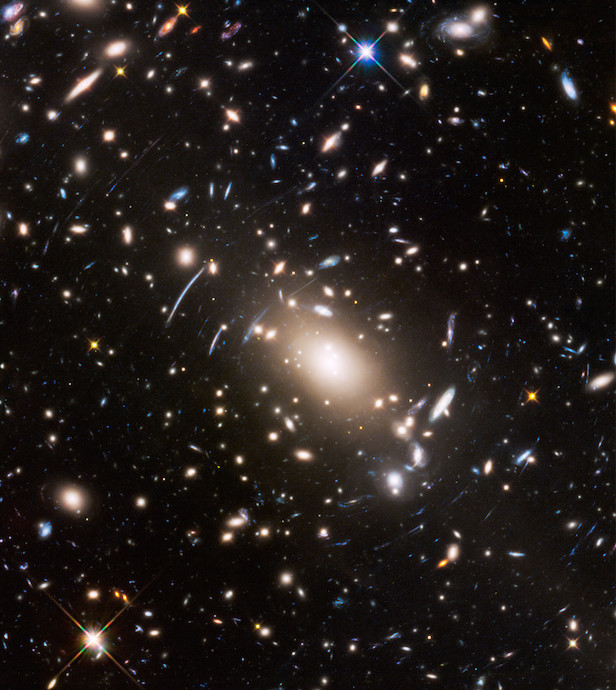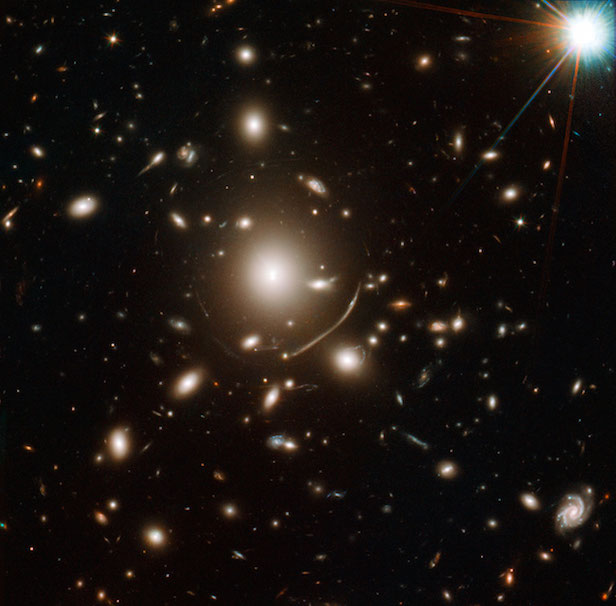‘Wobbling’ galaxies upset our understanding of dark matter
This unusual phenomenon within galaxy clusters may indicate to a new physics at work

Abell S1063, a galaxy cluster, was observed by the Hubble Space Telescope as part of the Frontier Fields programme. Image credit: NASA/ESA/J. Lotz (STScl)
The Hubble Space Telescope has helped astronomers discover that the brightest galaxies within several galaxy clusters “wobble” relative to their centre of mass. These results don’t comply with the predictions made by the current theory of dark matter, and further analysis of this inconsistency could introduce the implication of a new physics at work.
Dark matter makes up twenty-five percent of the universe, with normal matter making up a minuscule five per cent, but this is matter we cannot observe directly, making it one of the biggest mysteries in modern astronomy. Previous observations have shown us that dark matter encloses galaxies and galaxy clusters in the form of a massive halo. Within the clusters, galaxies are not only surrounded by large concentrations of dark matter, but by large amounts of hot intergalactic gas.
Within each of the dense cores of the clusters is a massive galaxy called the “brightest cluster galaxy” (BCG). If the cold dark matter theory is correct, then once a galaxy cluster is stabilised after a merger event, a BCG should not be able to move. This is due to the enormous gravitational influence of the dark matter keeping it in place.
However, a group of astronomers from Britain, Switzerland and France analysed ten galaxies from the Hubble archives and concluded that the BCGs don’t stay in a fixed position. Instead, they tend to ‘wobble’ around the centre of mass in their host cluster. This also means that the centre of the visible parts of each galaxy cluster and the centre of the total mass – including the dark matter – of the system is offset by as much as 40,000 light years.

Gravitational lensing occurs when an object with an vast mass, like a galaxy cluster, can bend the light of distant objects due to its enormous gravitational pull. Image creditL NASA/ESA/J. Richard (CRAL)/J.-P. Kneib (LAM)/M. Postman (STScl)
“We found that the BCGs wobble around centre of the haloes,” explains David Harvey, astronomer at EPFL, Switzerland. “This indicates that, rather than a dense region in the centre of the galaxy cluster, as predicted by the cold dark matter model, there is a much shallower central density. This is a striking signal of exotic forms of dark matter right at the heart of galaxy clusters.”
The only reason this unexpected result could be measured is because each galaxy cluster acts as a gravitational lens, which is a massive enough object in which its intense gravity can bend light from background object. This effect, also known as strong gravitational lensing, is important for astronomers to map the dark matter distribution within the cluster. From this, the astronomers can also measure the exact position for the centre of mass and determine the BCG’s offset position.
If this wobbling cannot be explained by a previously unknown astrophysical phenomenon and turns out to be the result of dark matter, then it is strongly inconsistent with our current understanding of cold dark matter. Dark matter could only explain this event if it means that the particles are interacting with each other. This is a strong contradiction of our currently leading theory of dark matter, and this may require a new theory for fundamental physics to solve this mystery.
“We’re looking forward to larger surveys — such as the Euclid survey — that will extend our dataset,” says Frederic Courbin, also of EPFL. “Then we can determine whether the wobbling of BGCs is the result of a novel astrophysical phenomenon or new fundamental physics. Both of which would be exciting!”
Keep up to date with the latest reviews in All About Space – available every month for just £4.99. Alternatively you can subscribe here for a fraction of the price!




